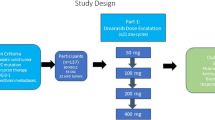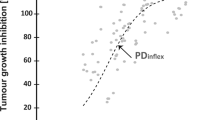Abstract
We have used a series of drug resistant continuous tumour cell lines of murine, hamster or human origin, to screen in vitro for new drugs effective at overcoming resistance expressed to clinically useful antitumour drugs. We have established that spirogermanium appears to express a unique lack of cross resistance to a wide range of ‘standard’ antitumour drugs including 5-fluorouracil, cisplatin, methotrexate, vincristine and adriamycin, as judged by its equivalent effectiveness in reducing survival, measured by clonogenic assays, of the parental and drug-resistant sublines following 24 hour in vitro treatments. Spirogermanium was also able to overcome the multidrug resistance exhibited by the colchicine-resistant mutant CHRC5 cells and a subline of vincristine-resistant MCF-7 human breast carcinoma cells, following 1 or 24 hour drug treatments. These preclinical studies suggest that this novel compound may prove a potentially useful agent for inclusion in ‘non-cross-resistant drug combinations’.
Similar content being viewed by others
References
Goldie JH, Coldman AJ, Gudauskas GA: Rationale for the use of alternating non-cross-resistant chemotherapy. Cancer Treat Rep 66:439–449, 1982
Johnson RK, Chitnis MP, Embrey WM, Gregory EB: In vivo characteristics of resistance and cross-resistance of an adriamycin-resistant subline of P388 leukemia. Cancer Treat Rep 62:1535–1547, 1978
Schabel FM, Skipper HE, Trader MW, Laster WR, Corbett TH, Griswold DP: Concepts for controlling drug-resistant tumor cells. In: Mouridsen HT, Palshof T (eds): Breast Cancer. Experimental and Clinical Aspects. Pergamon Press, Elmsford, New York 1980, pp 199–211
Bech-Hansen NT, Till JE, Ling V: Pleiotropic phenotype of colchicine resistant CHO cells: cross-resistance and collateral sensitivity. J Cell Physiol 88:23–32, 1976
Wilkoff LJ, Dulmadge EA: Resistance and cross-resistance of cultured leukemia P388 cells to vincristine, adriamycin, adriamycin analogs and actinomycin D. J Natl Cancer Inst 61:1521–1524, 1978
Beck WT: Vinca alkaloid-resistant phenotype in cultured human leukemia lymphoblasts. Cancer Treat Rep 67:875–882, 1983
Hill BT: Collateral sensitivity and cross-resistance. In: Fox BW, Fox M (eds): Handbook of Experimental Pharmacology. Springer-Verlag, Heidelberg, 1984, pp 673–697
Biedler JL, Riehm H: Cellular resistance to actinomycin D in Chinese hamster cells in vitro: cross-resistance, radioautographic and cytogenetic studies. Cancer Res 30:1174–1184, 1970
Ling V: Genetic basis of drug resistance in mammalian cells. In: Bruchovsky N, Goldie JH (eds): Drug and Hormone Resistance in Neoplasia, Volume 1. CRC Press, Boca Raton, Florida, 1982, pp 2–20
Kartner N, Riordan JR, Ling V: Cell surface P-glycoprotein is associated with multidrug resistance in mammalian cells. Science 221:1285–1288, 1983
Conter V, Beck WT: Acquisition of multiple drug resistance by CCRF-CEM cells selected for different degrees of resistance to vincristine. Cancer Treat Rep 68:831–839, 1984
Bell DR, Gerlach JH, Kartner N, Buick RN, Ling V: Detection of P-glycoprotein in ovarian cancer: a molecular marker associated with multidrug resistance. J Clin Oncol 3:311–315, 1985
Bell DR, Gerlach JH, Ling V: Detection of P-glycoprotein, a molecular marker associated with multidrug resistance, in human sarcoma. (Abstract) Proc Am Soc Clin Oncol 4:7, 1985
Slavik M, Blanc O, Davis J: Spirogermanium: A new investigational drug of novel structure and lack of bone marrow toxicity. Invest New Drugs 1:225–234, 1983
Hill BT, Price LA, Goldie JH: The value of adriamycin in overcoming resistance to methotrexate in tissue culture. Eur J Cancer 12:541–549, 1976
Hill BT: Preclinical screening for drugs effective against 5-fluorouracil-resistant cells with a murine L5178Y cell line in vitro. J Natl Cancer Inst 71:335–340, 1983
Hill BT, Goldie JH, Price LA: Studies concerned with overcoming resistance to methotrexate. A comparison of the effects of methotrexate and 2,4-diamino-5 (3′,4′-dichlorophenyl)-6-methylpyrimidine on the colony-forming ability of L5178Y cells. Brit J Cancer 28:262, 1973
Hill BT, Whelan RDH: Establishment of vincristine-resistant and vindesine-resistant lines of murine lymphoblasts in vitro and characterisation of their patterns of cross-resistance and drug sensitivities. Cancer Chemother Pharmacol 8:163–169, 1982
Drewinko B, Shaver A, Yang L-Y: Nutrient-dependent colony-forming capacity of cultured human colon carcinoma cells. Invest Cell Pathol 1:341–346, 1978
Gibby EM, Boyse O, Hill BT: A study of adriamycin resistance using human ovarian tumour cell lines. Br J Cancer 51:599–600, 1985
Courtenay VD, Mills J: An in vitro colony assay for human tumours grown in immune-suppressed mice and treated in vivo with cytotoxic agents. Br J Cancer 37:261–268, 1978
Soule HD, Vazquez J, Long A, Alberts S, Brennan M: A human line from a pleural effusion derived from a breast carcinoma. J Natl Cancer Inst 51:1409–1416, 1973
Ling V, Thompson LH: Reduced permeability in CHO cells as a mechanism of resistance to colchicine. J Cell Physiol 83:103–116, 1974
Hill BT, Whatley SA, Bellamy AS, Jenkins LY, Whelan RDH: Cytotoxic effects and biological activity of 2-aza-8-germanspiro [4, 5]-decane-2-propanamine-8,8-diethyl-N, N-dimethyl dichloride (NSC 192965; Spirogermanium) in vitro. Cancer Res 42:2852–2856, 1982
Ling V, Kartner N, Sudo T, Siminovitch L, Riordan JR: Multidrug resistance phenotype in Chinese hamster ovary cells., Cancer Treat Rep 67:869–874, 1983
Rice LM, Wheeler JW, Geschickter CF: Spirans XXII. Synthesis of 4,4-dialkyl-4-germacyclohexanone and 8,8-dialkyl-8-germaazaspiro-[4,5]decanes. J Heterocycl Chem 11:1041–1047, 1974
Hill BT, Bellamy AS, Metcalfe S, Hepburn PJ, Masters JRW, Whelan RDH: Identification of synergistic combinations of Spirogermanium with 5-fluorouracil or cisplatin using a range of human tumour cell lines in vitro. Invest New Drugs 2:29–33, 1984
Vogelzang NJ, Gesme DH, Kennedy BJ: A phase II study of Spirogermanium in advanced human malignancy. Am J Clin Oncol 8:341–344, 1985
Author information
Authors and Affiliations
Rights and permissions
About this article
Cite this article
Hill, B.T., Whelan, R.D.H. Spirogermanium — A novel antitumour agent expressing a lack of cross-resistance in vitro with a range of ‘standard’ antitumour drugs. Invest New Drugs 4, 359–365 (1986). https://doi.org/10.1007/BF00173508
Issue Date:
DOI: https://doi.org/10.1007/BF00173508




